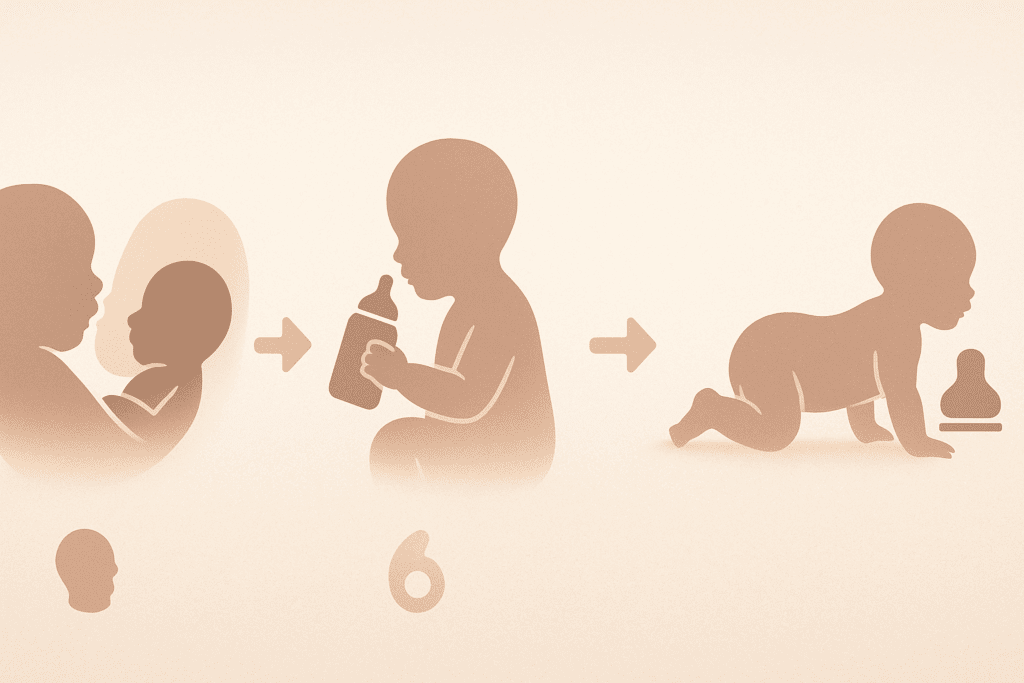Welcoming a newborn into the world brings unparalleled joy, but it also introduces new rhythms and patterns that can leave even the most prepared caregivers feeling disoriented. One such rhythm, often misunderstood and emotionally taxing, is newborn cluster feeding at night. This behavior, where an infant feeds in rapid succession during evening or nighttime hours, is common during critical periods of growth and neurological development. Yet, without clear guidance and a nuanced understanding of its biological and psychological foundations, parents may experience unwarranted stress, fatigue, and confusion. This article provides essential insights into cluster feeding, particularly its occurrence at night, and offers evidence-based strategies to help soothe and support both baby and caregiver through these intense yet entirely normal phases.
You may also like: Essential Milestones in Baby Led Weaning: A Proven Guide to Nurturing Healthy Eating Habits

Understanding the Biological Basis of Cluster Feeding
To grasp the rationale behind cluster feeding, especially during the night, one must first understand its role in the physiology of newborns. Human infants are born with small stomachs and high caloric needs, especially in the first weeks of life. Because breast milk is quickly digested, frequent feeding ensures that babies receive the necessary nutrients and calories to support rapid cellular growth, brain development, and immune function. Cluster feeding helps meet these needs efficiently. During a cluster feeding session, infants may nurse every 30 to 60 minutes for several hours, most commonly in the late afternoon and evening. This behavior isn’t indicative of inadequate milk supply or hunger caused by insufficient feeding during the day; rather, it is nature’s way of optimizing calorie intake before long sleep stretches begin to form.
The hormonal interplay between mother and infant during cluster feeding is another critical component. Prolactin and oxytocin, hormones essential for milk production and ejection, peak during frequent nursing sessions. This hormonal surge not only supports milk supply but also strengthens the maternal-infant bond, creating a feedback loop that enhances both emotional connection and physiological nourishment. By responding to frequent feeding cues, mothers help ensure the establishment of a robust milk supply while reinforcing the infant’s sense of security.

Why Newborns Cluster Feed More Frequently at Night
While cluster feeding can occur at any time of day, it is most often observed in the evening or at night. Several factors contribute to this phenomenon. First, newborns’ circadian rhythms are not yet developed, meaning their sleep-wake cycles are not aligned with the day-night pattern. Their bodies are still adjusting to life outside the womb, where they experienced a consistent environment of darkness and motion. As they adapt, they often experience periods of restlessness in the evening, which can trigger increased feeding behaviors as a self-soothing mechanism.
Second, milk composition changes throughout the day. Evening breast milk typically contains higher concentrations of tryptophan, a precursor to melatonin, the hormone that regulates sleep. When babies cluster feed during the evening, they receive increased doses of these sleep-promoting compounds, which may help them consolidate sleep later in the night. This biological rhythm reinforces the evolutionary advantage of evening cluster feeding as a preparatory act for nighttime rest.
Additionally, maternal fatigue or stress during evening hours can contribute to perceptions of increased feeding needs. A fussy baby who appears to demand frequent feeding might actually be responding to subtle cues from a tired or anxious caregiver. Recognizing that this pattern is a natural response, not a failure of milk supply or parenting, is essential for alleviating caregiver stress.

Signs of Cluster Feeding and How to Recognize the Stages
Distinguishing cluster feeding from other behaviors is crucial for caregivers seeking clarity and peace of mind. Cluster feeding is characterized by a pattern rather than a single instance of frequent feeding. A typical cluster feeding session involves multiple feedings in short succession over a span of two to six hours, interspersed with fussiness and brief naps. Unlike a growth spurt where feeding increases over the course of a day or two, cluster feeding often presents as an isolated period of heightened nursing within a 24-hour cycle.
Several recognizable stages accompany cluster feeding. The first stage involves initial hunger cues such as rooting, sucking on hands, or increased alertness. If these cues are met with prompt feeding, the infant is likely to remain calm and engaged. The second stage features escalating demands, including more frequent latching and increased crying if feeding cues are missed. The third stage is a mix of feeding, brief sleep, and agitation, which can be mistaken for colic or discomfort. By identifying these stages, caregivers can better anticipate needs and respond proactively.
Moreover, infant cluster feeding should be viewed in light of developmental milestones. Around three weeks, six weeks, and three months—common times for growth spurts—infants often enter phases of cluster feeding. These periods correspond with rapid neurological and physical development, during which caloric needs and the desire for physical closeness peak. By recognizing these patterns, parents can differentiate between normal feeding behavior and potential feeding issues.

Newborn Cluster Feeding at Night: Supporting the Infant’s Nutritional Needs
Cluster feeding at night plays a pivotal role in supporting newborn nutritional needs during key developmental windows. The first six weeks of life are characterized by intense growth, with infants typically gaining about five to seven ounces per week. This rapid development necessitates frequent access to high-quality nutrients, particularly fats and proteins found in breast milk. By engaging in cluster feeding, newborns effectively increase milk intake without overloading their immature digestive systems.
Furthermore, nighttime feedings are hormonally beneficial for lactating parents. Prolactin levels, which regulate milk production, peak during nighttime hours. Frequent feeding during this window stimulates greater long-term milk output and ensures that the infant continues to receive adequate nutrition even during less frequent daytime sessions. This dynamic underlines why restricting nighttime feeds in the early months can be counterproductive to both milk supply and infant health.
Cluster feeding at night also supports the development of the infant’s gut microbiome. Each feeding introduces beneficial bacteria and bioactive compounds that shape the infant’s immune system and metabolic function. As newborns cluster feed more intensively during the night, their gastrointestinal systems receive continuous support for maturation and microbial colonization. This factor reinforces the importance of viewing cluster feeding not as an inconvenience but as a biologically valuable practice.
Why Do Newborns Cluster Feed? Psychological and Developmental Perspectives
Understanding why newborns cluster feed requires delving into the psychological and developmental aspects of early infancy. Cluster feeding fulfills more than nutritional needs—it also provides emotional regulation, sensory stimulation, and bonding opportunities. In the early weeks of life, infants experience the world through touch, scent, and sound, all of which are concentrated during nursing. Feeding becomes a source of comfort and a mechanism for coping with overstimulation.
Cluster feeding sessions often occur during periods of heightened sensory awareness. As infants process their environment—sights, sounds, and interactions—they may become overwhelmed. Nursing provides a predictable and calming experience that helps mitigate this sensory input. Thus, frequent feeding serves not only to satiate hunger but to emotionally ground the infant during times of sensory flux.
Moreover, cluster feeding fosters attachment between infant and caregiver. The repetitive closeness of feeding provides continuous opportunities for eye contact, skin-to-skin interaction, and vocal exchange. These interactions stimulate the release of oxytocin, enhancing the infant’s sense of safety and the caregiver’s emotional well-being. From a developmental perspective, cluster feeding is a natural extension of the bonding process, reinforcing the infant’s trust and confidence in the caregiver’s availability.

Soothing Strategies for Managing Newborn Cluster Feeding at Night
Navigating the demands of cluster feeding at night requires a blend of emotional resilience, practical preparation, and compassionate self-care. One effective approach is to create a calming nighttime routine that signals to both baby and caregiver that a transition into evening rest is beginning. This can include dimming lights, reducing external noise, and incorporating soothing rituals like baths or gentle massages. These environmental cues help condition the infant’s nervous system to wind down, making cluster feeding sessions less frantic and more rhythmic.
Skin-to-skin contact remains one of the most effective methods for soothing a cluster feeding newborn. Holding the baby against the chest regulates their body temperature, heartbeat, and breathing, promoting a state of physiological calm that makes feeding more efficient and less stressful. This position also encourages spontaneous latching and prolongs periods of calm alertness, which are ideal for feeding.
Another helpful strategy involves pacing feedings and offering comfort even when the baby is not actively nursing. Paced bottle feeding for breastfed babies, using slow-flow nipples and upright positions, can mimic breastfeeding rhythms and reduce frustration during cluster feeding. For exclusively breastfed babies, responsive nursing—offering the breast at the first sign of restlessness—can prevent escalation into crying and help maintain a peaceful nighttime atmosphere. Finally, caregivers should prioritize their own well-being by staying hydrated, taking short rest breaks, and enlisting support when possible. An emotionally balanced caregiver is better equipped to meet the complex needs of a cluster feeding infant.

Recognizing the Difference Between Cluster Feeding and Feeding Issues
While cluster feeding is a normal behavior, it is essential to distinguish it from potential feeding problems that may require medical or lactation support. If a baby is consistently fussy during or after feeds, appears unsatisfied after nursing, or shows signs of poor weight gain, these may be indicators of issues such as tongue-tie, poor latch, or insufficient milk transfer. Cluster feeding, by contrast, is typically characterized by contentment between feedings and steady growth over time.
Another point of differentiation is the presence of maternal discomfort. While some nipple soreness is common in the early days of breastfeeding, persistent pain or damage may signal a latch issue that needs to be addressed. Likewise, maternal concerns about milk supply should be guided by objective measures, such as diaper output and weight gain, rather than perceived feeding frequency alone. In cases of uncertainty, consulting a lactation consultant or pediatrician can provide reassurance and actionable guidance.
It’s also important to evaluate the baby’s behavior outside of cluster feeding sessions. If an infant is irritable throughout the day, has difficulty sleeping, or shows signs of gastrointestinal distress such as excessive gas, reflux, or abnormal stools, these symptoms may point to underlying medical concerns. Cluster feeding, though intense, typically occurs in a predictable pattern and is followed by periods of restful sleep and alert wakefulness.
Supporting the Caregiver Through Nighttime Cluster Feeding
The emotional and physical toll of cluster feeding at night can be significant, especially when sleep deprivation compounds feelings of inadequacy or isolation. Supporting the caregiver through these periods is just as critical as nurturing the infant. One of the most empowering tools is education—understanding that cluster feeding is a developmental norm helps reframe it from a problem into a purposeful behavior.
Caregivers benefit greatly from proactive self-care practices, such as preparing easy-to-access snacks and hydration stations near the nursing area. Comfortable seating, pillows for proper positioning, and entertainment like audiobooks or music can transform the cluster feeding experience from draining to restorative. When possible, alternating responsibilities with a partner or enlisting the help of friends or family can also ease the burden.
Emotional support is equally vital. Talking with other parents, whether through in-person support groups or online communities, can provide validation and encouragement. Hearing that others have navigated similar experiences with success reinforces a sense of solidarity and competence. Healthcare providers should also offer empathetic, evidence-based guidance that acknowledges both the challenges and the strengths of nighttime caregiving. With the right support, caregivers can emerge from the cluster feeding phase more confident, connected, and resilient.

Navigating Cluster Feeding Stages with Developmental Awareness
Cluster feeding stages often align with critical developmental windows, and being attuned to these connections can enhance a caregiver’s ability to respond effectively. During the first six weeks, cluster feeding supports not only physical growth but also the establishment of circadian rhythms and breastfeeding patterns. At this stage, consistency and patience are key, as babies are learning to regulate their own bodies in a brand-new world.
By the time infants reach three to four months, cluster feeding may reappear during cognitive leaps, such as increased visual tracking, hand-eye coordination, and social smiling. These milestones are often accompanied by greater distractibility during the day and a resurgence of nighttime feeding. Recognizing these patterns helps caregivers respond with empathy rather than frustration.
Later cluster feeding stages may coincide with teething, illness recovery, or environmental transitions, such as travel or changes in caregiver routines. These stressors often drive babies to seek the comfort and predictability of feeding. By linking behavioral changes to developmental context, caregivers can anticipate needs and adapt strategies accordingly. This approach reduces anxiety and enhances the ability to meet the evolving needs of the child.
The Long-Term Benefits of Responsive Cluster Feeding
Though exhausting in the moment, cluster feeding provides long-term benefits that support healthy growth and emotional resilience. From a nutritional standpoint, frequent feeding helps establish optimal milk supply, reduces the risk of dehydration, and ensures that the baby receives a diverse array of bioactive compounds that protect against infection and support brain development. These advantages form a foundation of robust health in infancy and beyond.
Emotionally, responsive feeding reinforces the infant’s sense of security and attachment, which contributes to stable emotional development and social functioning later in life. Research has shown that securely attached infants are more likely to explore their environments confidently and form healthy relationships as they grow. Cluster feeding is one of many behaviors that nurture this emotional security.
For the caregiver, engaging fully in the cluster feeding process cultivates mindfulness, patience, and attunement. These skills not only improve the immediate caregiving experience but also contribute to long-term confidence and competence in parenting. When caregivers view cluster feeding as an opportunity rather than a burden, they create an environment of mutual growth, trust, and well-being.
Frequently Asked Questions About Newborn Cluster Feeding at Night and Related Patterns
How can caregivers differentiate newborn cluster feeding at night from sleep regressions or colic?
Newborn cluster feeding at night often presents as a predictable pattern of frequent, short feedings within a condensed window of time, usually occurring in the late evening hours. In contrast, sleep regressions typically occur in older infants and involve disrupted sleep without a direct link to feeding. Colic, on the other hand, involves prolonged crying and distress, often with a set onset time daily, and is not alleviated by feeding. One key distinction is that babies engaged in cluster feeding will usually show brief periods of satisfaction between feeds, maintain strong suckling behavior, and demonstrate adequate weight gain. Understanding these nuances helps caregivers respond appropriately without misinterpreting cluster feeding newborn behaviors as pathological when they are, in fact, developmentally normal.
What are some advanced calming strategies for parents during cluster feeding stages?
Beyond basic soothing methods, parents can explore integrative techniques such as low-frequency sound therapy, aromatherapy with calming scents like lavender, or structured relaxation techniques including progressive muscle relaxation while feeding. Dim lighting with red-spectrum bulbs can help support circadian rhythm development in both infant and caregiver, reducing overstimulation during nighttime cluster feeding. Additionally, synchronizing parental breathing patterns with the infant’s can create a calming biofeedback loop that promotes emotional regulation. Parents can also keep a personalized cluster feeding journal to identify trends and triggers, fostering a sense of control and predictability. These layered approaches allow caregivers to create a nurturing nighttime routine that aligns with the baby’s needs while protecting their own well-being.
Can newborn cluster feeding at night affect long-term sleep development?
Yes, it can influence the foundation for future sleep habits, but not in the way many parents fear. Cluster feeding at night is nature’s mechanism to help newborns fill up before longer sleep stretches, particularly as their circadian rhythms begin to develop. By supporting these feeding patterns, caregivers encourage the baby’s ability to eventually consolidate nighttime sleep. However, if cluster feeding is prematurely interrupted—such as by scheduled feeding or early sleep training—it may delay the maturation of these natural rhythms. Embracing cluster feeding stages and gradually transitioning to sleep training when developmentally appropriate can yield smoother long-term sleep outcomes.
Why do newborns cluster feed more during developmental leaps?
Developmental leaps often bring new sensory processing challenges and mental growth, which can leave infants feeling overstimulated or anxious. In these moments, cluster feeding provides a multi-sensory experience that soothes and organizes their internal state. It offers consistent access to warmth, nourishment, touch, and parental voice—key anchors during times of internal upheaval. Many caregivers report increased cluster feeding at night during milestones such as the first social smile or new visual tracking abilities. These behaviors are not random but tied to the baby’s intrinsic need for reassurance and regulation as their brain rewires rapidly during early infancy.
What does cluster feeding mean for maternal mental health, and how can partners help?
Cluster feeding, especially during nighttime hours, can contribute to maternal exhaustion and emotional vulnerability. When not understood or supported, these extended feeding windows may lead to frustration or feelings of inadequacy. Partners play a vital role by sharing night duties like burping, diapering, or simply offering moral support during feedings. Encouraging scheduled self-care breaks, validating the mother’s experience, and taking over daytime responsibilities can dramatically improve maternal mental health. Building a shared understanding of why newborns cluster feed reduces resentment and fosters a collaborative parenting approach that sustains both the mother and the partnership.
How can parents prepare for cluster feeding newborn behaviors during travel or major routine changes?
When anticipating travel or changes such as moving or returning to work, parents can proactively manage cluster feeding by reinforcing consistency in feeding and sleep environments. Familiar swaddles, nursing pillows, or white noise machines can serve as portable comfort items that signal feeding time. Maintaining as much of the evening routine as possible, even in new settings, supports infant cluster feeding rhythms. It’s also helpful to buffer extra time into schedules around typical cluster feeding windows to reduce stress. Recognizing that travel may temporarily increase nighttime cluster feeding helps parents stay flexible and prioritize the baby’s emotional and nutritional needs.
Optimizing Parental Resilience During Newborn Cluster Feeding at Night
Cluster feeding at night, while biologically purposeful, can feel overwhelming. To build resilience, caregivers should adopt a mindset that frames these feedings as investments in long-term health, not inconveniences. Resilience is further strengthened by engaging in non-negotiable self-care rituals—hydration, nutrition, and even small pleasures like soothing teas or 10-minute meditations between feeds. Community support is another pillar of resilience; connecting with other parents navigating cluster feeding newborn experiences can be a powerful antidote to isolation. Clinical support through lactation consultants or postpartum therapists also provides professional insight and emotional grounding. These combined efforts create a more balanced and sustainable caregiving experience.
The Role of Hormonal Shifts in Cluster Feeding at Night
One underexplored factor in cluster feeding at night is the role of the maternal hormonal environment. During nighttime hours, higher levels of prolactin stimulate milk production and may prompt infants to feed more frequently in sync with this hormonal surge. Meanwhile, oxytocin not only facilitates milk let-down but also enhances maternal bonding and stress reduction, reinforcing the baby’s desire for frequent contact. These hormonal fluctuations also explain why some mothers feel more emotional or introspective during nighttime cluster feeding sessions. By understanding this hormonal context, caregivers can normalize their emotional responses and appreciate the physiological choreography behind infant cluster feeding behaviors.
Why Do Newborns Cluster Feed Even After a Full Feeding?
Some newborns engage in what appears to be cluster feeding shortly after a seemingly complete meal, leading parents to question milk sufficiency. However, this behavior often reflects a developmental need rather than true hunger. For instance, during periods of sensory overload or emotional distress, a baby may seek the breast not for nutrition but for comfort, scent, or security. This behavior is especially common during cluster feeding stages when infants are adjusting to new stimuli or transitions. Responding to these cues without judgment promotes emotional regulation and strengthens the trust between infant and caregiver, even if it feels counterintuitive to feed again so soon.
How to Promote Healthy Sleep After Intense Newborn Cluster Feeding at Night
Post-cluster feeding sleep can be enhanced through techniques that reinforce circadian rhythm development. This includes maintaining a consistent dim-light environment during the evening and exposing the baby to natural daylight in the morning to help reset their internal clock. Using gentle sensory transitions—such as soft lullabies, warm baths, or swaying—can also signal the brain to wind down. After an intense night of cluster feeding, some infants benefit from swaddling or a firm surface for sleep to feel secure. Over time, these practices help babies differentiate night from day and consolidate sleep more effectively, even as cluster feeding at night remains a periodic necessity.
Conclusion: Reflecting on the Importance of Newborn Cluster Feeding at Night
In the ever-evolving journey of parenting, few experiences are as immersive and formative as managing newborn cluster feeding at night. This natural, biologically driven behavior challenges conventional expectations of infant sleep and feeding patterns but delivers profound benefits for growth, bonding, and emotional development. By understanding what cluster feeding means and recognizing its stages, caregivers can respond with knowledge, compassion, and adaptability.
Rather than a problem to be solved, cluster feeding is a window into the intricate dance of early human development—a dance choreographed by biology, shaped by environment, and enriched through love and presence. By supporting caregivers and empowering them with evidence-based tools and insights, we not only improve the immediate feeding experience but lay the groundwork for healthier, more connected parent-child relationships for years to come. As science continues to uncover the nuances of infant cluster feeding, one truth remains clear: responding with warmth, consistency, and understanding during these nighttime hours has the power to transform the challenges of early parenthood into moments of deep connection and enduring growth.
Further Reading:
Why Does My Baby Cluster Feed at Night? | Nighttime Nourishment



